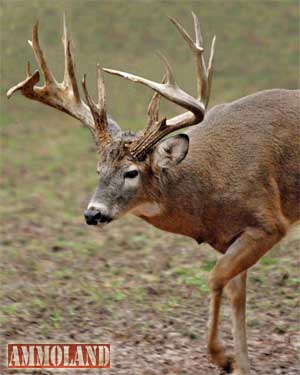Truth and Fiction About Deer Tracks
by J. Wayne Fears

Pottstown PA –-(Ammoland.com)- Because so much misinformation exists about deer tracks and what information they can communicate, I’ve talked to wildlife biologists and avid deer hunters to learn the truth about deer tracks.
Can You Tell the Sex of a Deer by Its Track?
“The only sure way to know if a deer track you’ve found is that of a buck or a doe is to see that animal standing in its track,” Dr. Bob Sheppard of Tuscaloosa, Alabama, an avid bowhunter and bowhunting instructor, says.
Although most wildlife scientists agree with Sheppard, Bob Zaiglin, a certified wildlife biologist in Texas, explains that, “Knowing the lay of the land is more important to bagging a buck than seeing deer tracks. But some experienced hunters can distinguish a buck by the size of the track and more importantly by the spread of the feet.” Joe Hamilton, a certified wildlife biologist, QDMA’s (Quality Deer Management Association) founder and the organization’s Director of Education for the South, believes that, “In much of the East, when a hunter spots a big track on the ground, more than likely he’s looking at the track of a large doe. In many areas, the does are allowed to live longer than the bucks, become bigger as they get older and make larger tracks.
However, in regions with snow, sand and/or mud, the buck may drag his feet and/or make deeper tracks.” Dr. Harry Jacobson, retired professor emeritus of Wildlife and Fisheries at Mississippi State University, states that, “If the tracks are very large, then a good chance exists that the tracks may have been made by a buck. But generally speaking, determining the sex of deer from tracks is very difficult.”

Can Does Have Bigger Tracks Than Bucks?
According to Dr. Jacobson, sometimes deer populations are so badly managed that hunting pressure eliminates a large majority of the bucks, whereas the does are treated like the sacred cows of India, allowed to put on heavier body weights and reach much-older-age classes than the bucks do. “That’s why often a doe’s track will be bigger than a buck’s track in places where the deer herd contains does that are older than the bucks.”
Can You Tell the Weight and/or Physical Condition of a Deer by Its Track?
Charles DeYoung, a research scientist and professor emeritus at Texas A&M University-Kingsville, mentions that you can note some general characteristics about deer, if you see their tracks side by side, particularly if one track is a fawn’s and the other a buck’s. But, “Generally you can’t determine this, unless you’re an Apache.”
Can You Tell from the Tracks Whether the Deer Is Walking or Running?
Dr. Keith Causey, a retired professor of wildlife science at Auburn University in Auburn, Ala., says, “Usually you can tell whether a deer is walking or running by the distance between the tracks, as well as whether the toes are spread on the impact from running.”
Does Seeing the Dew Claws as Part of the Track Indicate a Buck Has Made It?
Horace Gore, a long-time wildlife biologist, answers this question with, “No. Often the size of the animal and the medium the track is being placed in will determine the depth of the print and whether or not a dew claw is apparent in the print. In soft mud or clay, even the track of yearling deer may reveal a dew claw. In a freshly-plowed field, the print of a dew claw can be present as part of the track. However, a very-large buck walking across rock or hard clay may not leave a big track at all or a dew claw print in the track.”
Why Is Finding a Deer Trail with Tracks in Both Directions Important to Your Success?
Dr. Sheppard has learned that finding a trail with tracks going in both directions often signals he’s at a deer hot spot. “One of the best places to find this type of trail is in a funnel region where the terrain is necked-down by two-different types of converging habitats. Deer will move back and forth along this trail all day to get from one section of woods to the other part of the woods.” Horace Gore mentions that, “A trail like this means the deer probably are going to a food supply and coming back to a bedding ground. If the tracks only are going one way, then you don’t necessarily know what the deer are doing.”
How Important Is Locating Deer Tracks to a Successful Hunting Plan?
“Obviously, you want to see some deer tracks to reassure yourself psychologically that there are deer around,” Zaiglin mentions. “But on many places with dry, rocky terrain, like southern Texas and Mexico, you won’t see any tracks, even though plenty of deer may be in an area.” Gore believes tracks can be very important to a deer hunter’s scouting successfully. “If you’re scouting a spot looking for trails and deer sign but don’t find any tracks, probably no deer are in the region.”
Can You Identify the Track of a Deer and Continue to Hunt That Same Deer from Its Track?
Gore is skeptical about a hunter’s ability to determine that one particular track has been made by the same deer year after year. “If the deer’s track is exceptionally big, you may be able to say year after year that the same deer has made the track. But the deer will have to be an unusually large track.”
The main function deer tracks perform is to notify you that a deer has walked through a place at some time in the past. Discovering deer tracks is no guarantee the same deer will walk back through that region again. Generally deer tracks do not tell you the sex or the size of the deer.
To learn more about deer and their habits, go to www.jwaynefearsbrand.com, and see information about my “Deer Hunter’s Pocket Reference” book.
